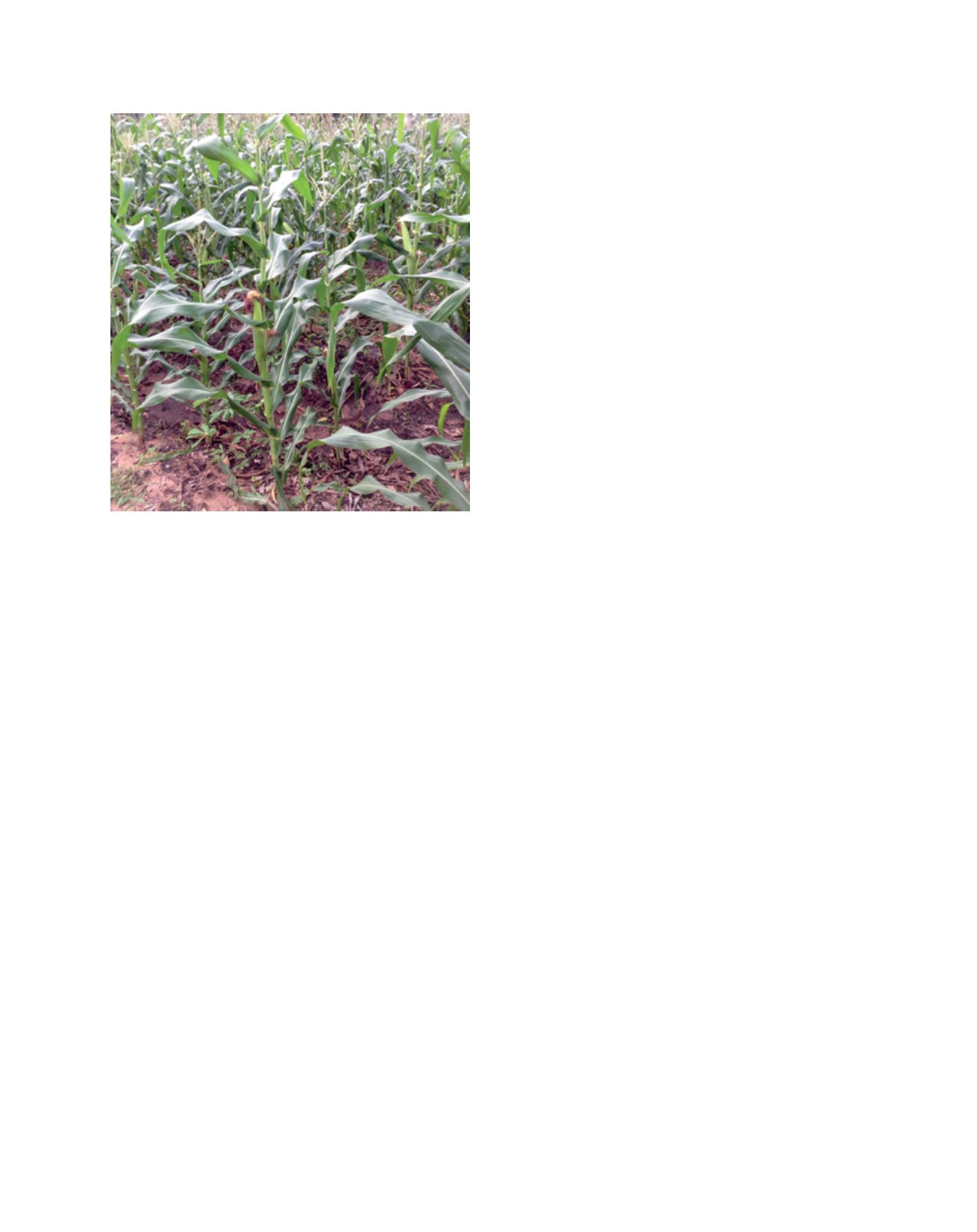

[
] 209
‘farming as a business’, and attended a field demonstration
on maize agronomy and field management practices that
was conducted by the local extension officer with facilita-
tion from NAAIAP.
The onset of the 2012 long rains was timely and Mrs
Kosgei’s maize, which was planted by the third week of
March, took off with a splendid tempo. By the fourth week of
April, however, the rains stopped suddenly. This happened
despite early predictions of good weather by the national
meteorological department. “In the last decade, we have
suffered a series of unreliable rainfall,” decried Mrs Kosgei
when she went to the NAAIAP local coordination office to
enquire about her fate and the predicament that the exten-
sion office attributed to climate change. Sympathetic with
her situation, the NAAIAP team toyed with various options,
the best being that of insuring the 1 acre of maize in order
to recover at least the cost of invested inputs should the
crop fail completely. Unfortunately, however, the insurance
option was untenable because of a lack of relevant crop-
based insurance service providers. An insurance consortium
known as UAP-Syngenta was the only one in the country that
offered a weather-based index at that time. Unfortunately,
Molo division where Mrs Kosgei farmed was not covered by
this insurance service.
The unpredictability of the weather, however, turned out
for the better in the following months of May and June
2012, which enabled Mrs Kosgei’s maize to recover though
not to fullness. By the end of the second week of May, Mrs
Kosgei was able to complete her second weeding, which she
followed soon after with top-dressing and the application
of pesticide to manage stem-borer, a common maize pest in
the region. By the end of the season, Mrs Kosgei managed
to harvest 18 bags of maize from her 1 acre piece of land.
According to the area extension staff, this yield represented
72 per cent of the potential maize yield in the division,
which is about 25 bags per acre. According to Mrs Kosgei,
however, this was the highest maize yield she had ever real-
ized. ”This is my greatest joy. I have discovered that using
the right inputs at the recommended rates really works,”
remarked a cheerful Mrs Koskei as she proudly displayed
her maize harvest to local extension staff who visited her
soon after harvesting.
Post-harvest loss is one of the major problems that blight
smallholder farmers in Africa. In Kenya, for example, the
national maize post-harvest loss is estimated at 10 per cent,
with common losses emanating from poor storage, pest and
rodent damage as well as discolouration and rotting due to
poor drying. Equally significant is the Aflatoxin menace which
is a challenge when rains come during the harvesting period.
To contain post-harvest losses, Mrs Kosgei attended further
training on cereal storage and post-harvest management prac-
tices that was conducted by the World Food Programme in
conjunction with the Cereal Growers Association (CGA),
to which Mrs Kosgei enrolled as a member. The CGA is an
umbrella body for cereal farmers that was formed with the
objective of empowering farmers and championing their
rights. It also helps farmers to market their produce.
With good post-harvest management and agribusi-
ness knowledge, Mrs Kosgei stored seven bags for family
consumption and sold six bags to generate Ksh18,000,
which she used to pay school fees for her daughter in a
nearby secondary school. Later, she sold the remaining five
bags at a much better price and raised Ksh17,500 which she
used to hire an additional acre of land and procure certified
maize seed and fertilizer to plant in the following season.
Commodity marketing is a major challenge among small-
holder farmers in rural areas. According to Mrs Kosgei,
most farmers sell their commodities cheaply to brokers
and thus remain poor because, first, the farmers have no
proper plans and means to manage pressing family financial
needs. Secondly, most farmers lack appropriate grain storage
facilities. Lastly, most farmers have not joined farmers’ asso-
ciations that help poor farmers gain market knowledge in
addition to access to negotiated credit.
By the start of the fourth planting season in March 2014,
Mrs Kosgei’s family had broken the poverty trap to become
successful medium-scale farmers in Molo division. She now
uses 7 acres of land under maize production, with esti-
mated annual gross income of Ksh 350,000. On her farm,
she now employs one permanent and six casual workers.
She has opened a bank account with Equity Bank in nearby
Molo town. To finance her farming activities, Mrs Kosgei
now gets a farming loan from Equity Bank. During 2014,
she borrowed up to Ksh105,000 to support various farming
activities. Further, Mrs Kosgei is now a role model and uses
part of her farm to educate other smallholder farmers on the
best methods of maize cultivation and post-harvest manage-
ment. She intends to enter politics during the next general
election as a Ward Women Representative. Mrs Kosgei is
forever grateful for the initial small support she got to start
her off. She continues to support Mr Yegon whose initial
voucher was the pathway to her family’s prosperity.
The programme uses maize to change farmers’ livelihoods
Image: NAAIAP
D
eep
R
oots
















